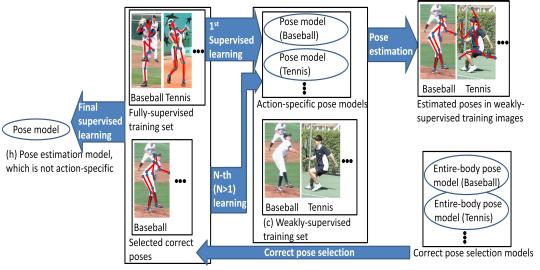Semi- and Weakly-supervised Human Pose Estimation
Norimichi Ukita
Yusuke Uematsu

Abstract
For human pose estimation in still images, this paper proposes three
semi- and weakly-supervised learning schemes. While recent advances
of convolutional neural networks improve human pose estimation using
supervised training data, our focus is to explore the semi- and
weakly-supervised schemes. Our proposed schemes initially learn
conventional model(s) for pose estimation from a small amount of
standard training images with human pose annotations. For the first
semi-supervised learning scheme, this conventional pose model detects
candidate poses in training images with no human annotation. From
these candidate poses, only true-positives are selected by a
classifier using a pose feature representing the configuration of all
body parts. The accuracies of these candidate pose estimation and
true-positive pose selection are improved by action labels provided to
these images in our second and third learning schemes, which are semi-
and weakly-supervised learning. While the first and second learning
schemes select only poses that are similar to those in the supervised
training data, the third scheme selects more true-positive poses that
are significantly different from any supervised poses. This pose
selection is achieved by pose clustering using outlier pose detection
with Dirichlet process mixtures and the Bayes factor. The proposed
schemes are validated with large-scale human pose datasets.
Manuscript
Citation
- Norimichi Ukita and Yusuke Uematsu,
Semi- and Weakly-supervised Human Pose Estimation,
Computer Vision and Image Understanding,
Volume 170, pp.67-78, May, 2018.
doi: 10.1016/j.cviu.2018.02.003.
(Impact factor 2018 = 2.645)

